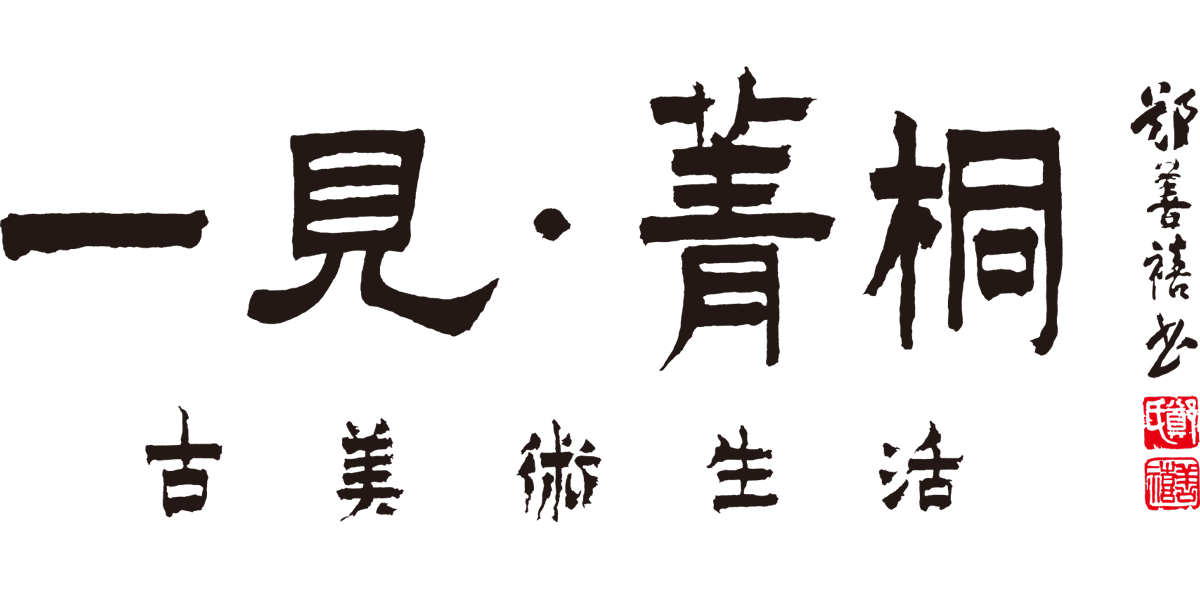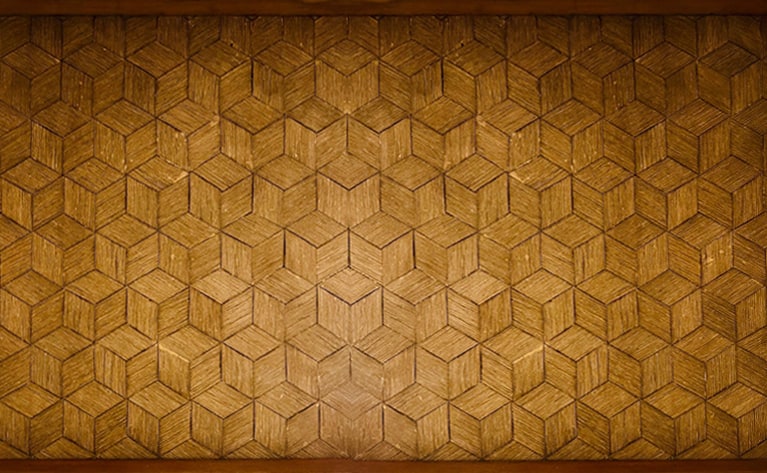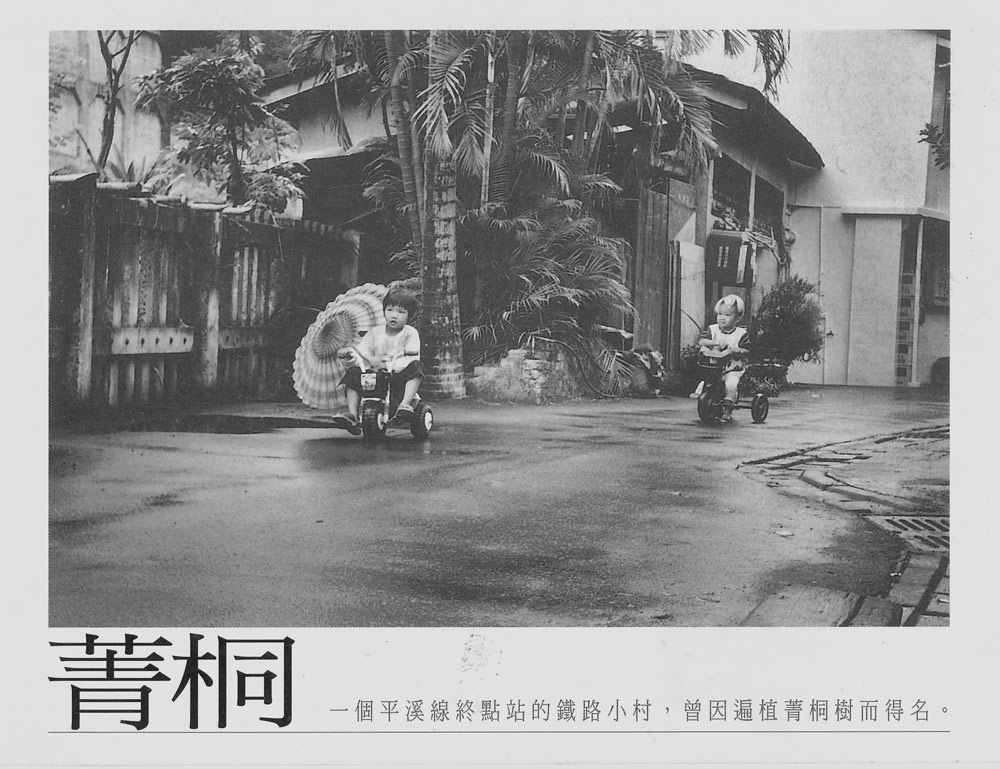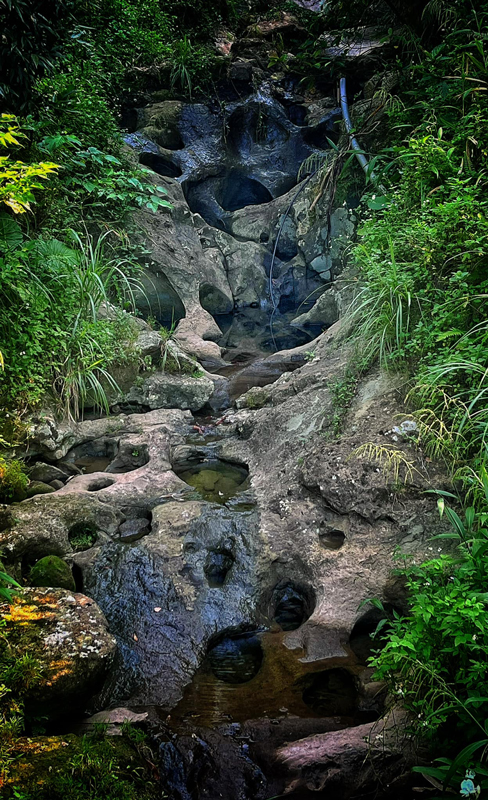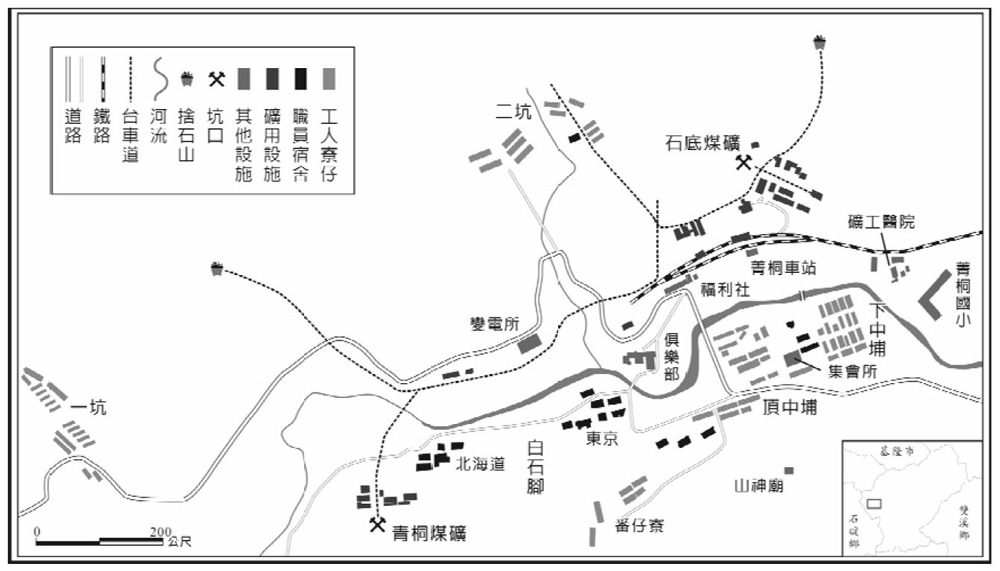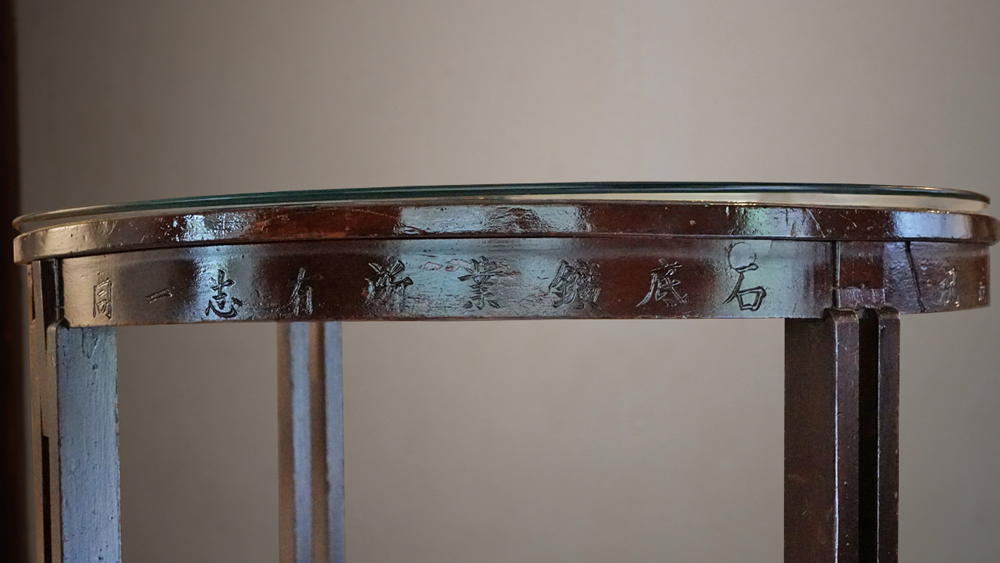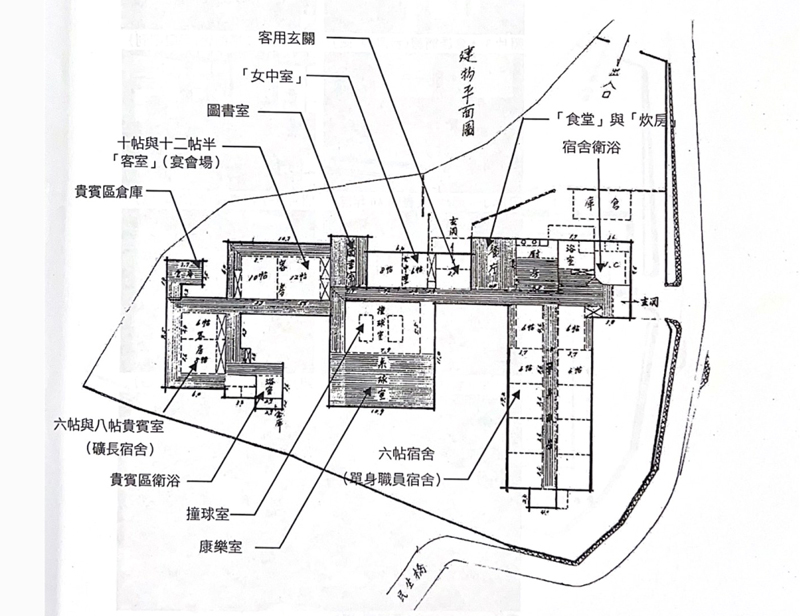![]()
Olden Days of the Ancient Manor
A maxim circulated the community at the onset of Pingxi’s development period: “The Central Mountain Range is the one-and-only real dragon of Taiwan, and Pingxi is where the head of the dragon rests. The water of Keelung came from the sky.” The Keelung River originates in the west-northwest side of the town of Shidi in Pingxi District. The riverbed of the upstream area is narrow and small, resulting in the great rapids that travel downward. The riverbed along the settlements is level and wide, and the water is so clear that the water-corroded rock surface on the bed is visible, hence the name, “Shidi” (“the bottom of the rock.)” The continued mountain-building process in Taiwan has also contributed to many unique geoscapes (such as the giant’s kettle).
Photo courtesy: Shijie Photography. FujiFilm Taiwan Gallery Joint Photography Exhibition, Postcard, dated 1999.
Pingxi used to be a rustic agricultural town in the mountains, producing camphor, teas, Mayflower gloryberries and tobacco for export. In the 40th year of Japanese emperor Meishi (1907), the first village chief of Pingxi Village, Pan Bingzhu, stumbled upon a rock stratum of coal in Shidi. Despite being granted the rights to mine the coals, no mining activity had ever commenced. In the following year (1908), the village commissioned a Japanese mining company, Fujita, to test-mine the area. The coals extracted were excellent in quality, and hefty in thickness. Yet the remoteness of the region made coal transportation impossible, so the project was suspended. In the following year, Mr. Pan saw that the Yan’s, a prominent coal-mining family of Taiwan, which owned two-thirds of Taiwan’s coal output, was successful in its excavation endeavors, and decided to sell the mining rights to the Yan’s.
“As Jinbaoli (‘Kimauri’) of the time, and Taiyang Mines, the foundation of Project Yunnian Clan has all been built upon the steadily-amassed industrial wealth and endeavors during the birth of the nation, and a thorough, thoughtful investigation.”
In the 7th Minguo calendar year (the 7th year of the Taisho era, 1918), Fujita corporation and the Yan family pooled their funds to establish Taipei Coal Mines Joint Stock Company (which was rechristened “Taiyang Mining Company”) to extract the coals in Pingxi in earnest. Due to the extent of the mountain range, and that the coals in Shidi could not be extracted from just one pit, Taiyang Mining Company decided to go for broke and invested in a rail system (which became the Pingxi route of today, at 12.9 kilometers) to help facilitate coal transportation of Shidi.
The project brought Pingxi unprecedented prosperity, inspiring local farmers to switch gears and join the more lucrative mining industry. It also attracted an influx of businesses from elsewhere and out-of-towners, thus ushering in the era of the black gold.
The Yan family had their tendrils in just about every industry at that time: finance, mining, transportation, the chemical industry, timber, warehousing, fishery, shipbuilding and food processing. In its prime, the Yan family owned more than 50 businesses. Among which was Taiyang Mining Company, located in Shidi, the largest rock strata of Taiwan. Its primary operation sat in Jingtong, where the Pingxi Guesthouse was established. It was also known as Shidi Club among the townspeople, due to the bustling mining activities in the region.
Photo courtesy: “Settlement and Resource Development of the Pingxi Region (1820 – 1969)”
A desk used during the launch of the Pingxi Guesthouse, kept until this day.
Spatial layout of the Pingxi Guesthouse as it was launched. Photo courtesy: “A Study of the Taipei County-designated Historic Site, ‘Pingxi Guesthouse of Taiyang Mining Company’ and Its Restoration”
This Japanese-style academy structure was erected in the 14th year of the Showa Era (1939). A high-profile architect was hired for the project, which took about a year to complete. The Guesthouse was officially inaugurated in the 15th year of the Showa era (1940), occupying an estate of 600-plus pings. The guesthouse structure took up 202 pings of the space. The interior is spacious and quiet, and the interior décor, be it the building material or the craftsmanship, is exquisite and elaborate. Formosan cypress and Taiwan yew constitute the primary building material. The guesthouse serves as a dorm for the staff, while offering leisure activities, reception services and boardroom accommodations. It bore witness to Taiyang Mining Company’s extreme wealth and power. This is why an architecture of such significance is located in Jingtong, and nowhere else.
The layout of the structure itself is quaintly asymmetrical, which brought about a rather unique spatial arrangement. It was different from the usual residential domicile in its design, since it was used primarily as an entertainment venue, a dorm, a service center and landscaped adornment.
This Japanese structure, when first launched, consisted of:
(1) A living space: dorm rooms (ten Japanese-style rooms with six tatami mats), guest bedrooms (Japanese-style rooms with six, eight, ten and twelve-and-a-half tatami mats), a reception room (the living room).
(2) Functional spaces: kitchen, cafes, maidservants’ rooms, entertainment rooms, billiard rooms, library, phone booth, bathrooms, restrooms, bathing rooms and warehouses.
(3) Connected spaces: hallways, foyers, corridors and engawas.
(4) Attached fixtures: spaces between beds, room section next to the alcove, columns, staggered shelves, fanlight, and shoins.
Top left is the briefing room, top right features a billiard room, bottom left is a ping pong table, and bottom right is a yearend banquet.
Photo courtesy: “A Study of the Taipei County-designated Historic Site, ‘Pingxi Guesthouse of Taiyang Mining Company’ and Its Restoration”
Fast-track to the 1970’s, production output started to dwindle due to difficulties with mine extraction in the depth of the pit; the new energy policy made gas and fuel the main power source; worse, imported coals competed for the domestic market share, and the onslaught of mining disasters also affected production. In 2000, the last remaining four mining factories were shut down forever, concluding Taiwan’s century-old mining industry. The town reverted to farming, as mining activities became a thing of the past.
References
Huang Chi-wei, 2004, Taiyang Company Chronicles, Taiwan Memory of National Central Library. See https://tm.ncl.edu.tw/
Tang Yu, 1997, Genealogy of the Yan Family of Keelung in Lukuo, family history compilation team for the Yan Family of Keelung
Hung Wei-hao, 2011, Settlement and Resource Development of the Pingxi Region (1820 – 1969), master’s thesis housed in the Graduate Institute of Geology of National Taiwan Normal University
Wang Hui-chun, 2007, A Study of the Taipei County-designated Historic Site, ‘Pingxi Guesthouse of Taiyang Mining Company’ and Its Restoration, Cultural Affairs Bureau of Taipei County Government
Fu Hung-ren, 2012, A Construction Progress Report on New Taipei City-designated Historic Site, the Pingxi Guesthouse of Taiyang Mining Company, Its Restoration and Reuse, Cultural Affairs Bureau of New Taipei City
![]()
Olden Days of the Ancient Manor
A maxim circulated the community at the onset of Pingxi’s development period: “The Central Mountain Range is the one-and-only real dragon of Taiwan, and Pingxi is where the head of the dragon rests. The water of Keelung came from the sky.” The Keelung River originates in the west-northwest side of the town of Shidi in Pingxi District. The riverbed of the upstream area is narrow and small, resulting in the great rapids that travel downward. The riverbed along the settlements is level and wide, and the water is so clear that the water-corroded rock surface on the bed is visible, hence the name, “Shidi” (“the bottom of the rock.)” The continued mountain-building process in Taiwan has also contributed to many unique geoscapes (such as the giant’s kettle).
Photo courtesy: Shijie Photography. FujiFilm Taiwan Gallery Joint Photography Exhibition, Postcard, dated 1999.
Pingxi used to be a rustic agricultural town in the mountains, producing camphor, teas, Mayflower gloryberries and tobacco for export. In the 40th year of Japanese emperor Meishi (1907), the first village chief of Pingxi Village, Pan Bingzhu, stumbled upon a rock stratum of coal in Shidi. Despite being granted the rights to mine the coals, no mining activity had ever commenced. In the following year (1908), the village commissioned a Japanese mining company, Fujita, to test-mine the area. The coals extracted were excellent in quality, and hefty in thickness. Yet the remoteness of the region made coal transportation impossible, so the project was suspended. In the following year, Mr. Pan saw that the Yan’s, a prominent coal-mining family of Taiwan, which owned two-thirds of Taiwan’s coal output, was successful in its excavation endeavors, and decided to sell the mining rights to the Yan’s.
“As Jinbaoli (‘Kimauri’) of the time, and Taiyang Mines, the foundation of Project Yunnian Clan has all been built upon the steadily-amassed industrial wealth and endeavors during the birth of the nation, and a thorough, thoughtful investigation.”
In the 7th Minguo calendar year (the 7th year of the Taisho era, 1918), Fujita corporation and the Yan family pooled their funds to establish Taipei Coal Mines Joint Stock Company (which was rechristened “Taiyang Mining Company”) to extract the coals in Pingxi in earnest. Due to the extent of the mountain range, and that the coals in Shidi could not be extracted from just one pit, Taiyang Mining Company decided to go for broke and invested in a rail system (which became the Pingxi route of today, at 12.9 kilometers) to help facilitate coal transportation of Shidi.
The project brought Pingxi unprecedented prosperity, inspiring local farmers to switch gears and join the more lucrative mining industry. It also attracted an influx of businesses from elsewhere and out-of-towners, thus ushering in the era of the black gold.
The Yan family had their tendrils in just about every industry at that time: finance, mining, transportation, the chemical industry, timber, warehousing, fishery, shipbuilding and food processing. In its prime, the Yan family owned more than 50 businesses. Among which was Taiyang Mining Company, located in Shidi, the largest rock strata of Taiwan. Its primary operation sat in Jingtong, where the Pingxi Guesthouse was established. It was also known as Shidi Club among the townspeople, due to the bustling mining activities in the region.
Photo courtesy: “Settlement and Resource Development of the Pingxi Region (1820 – 1969)”
A desk used during the launch of the Pingxi Guesthouse, kept until this day.
This Japanese-style academy structure was erected in the 14th year of the Showa Era (1939). A high-profile architect was hired for the project, which took about a year to complete. The Guesthouse was officially inaugurated in the 15th year of the Showa era (1940), occupying an estate of 600-plus pings. The guesthouse structure took up 202 pings of the space. The interior is spacious and quiet, and the interior décor, be it the building material or the craftsmanship, is exquisite and elaborate. Formosan cypress and Taiwan yew constitute the primary building material. The guesthouse serves as a dorm for the staff, while offering leisure activities, reception services and boardroom accommodations. It bore witness to Taiyang Mining Company’s extreme wealth and power. This is why an architecture of such significance is located in Jingtong, and nowhere else.
Spatial layout of the Pingxi Guesthouse as it was launched. Photo courtesy: “A Study of the Taipei County-designated Historic Site, ‘Pingxi Guesthouse of Taiyang Mining Company’ and Its Restoration”
The layout of the structure itself is quaintly asymmetrical, which brought about a rather unique spatial arrangement. It was different from the usual residential domicile in its design, since it was used primarily as an entertainment venue, a dorm, a service center and landscaped adornment.
This Japanese structure, when first launched, consisted of:
(1) A living space: dorm rooms (ten Japanese-style rooms with six tatami mats), guest bedrooms (Japanese-style rooms with six, eight, ten and twelve-and-a-half tatami mats), a reception room (the living room).
(2) Functional spaces: kitchen, cafes, maidservants’ rooms, entertainment rooms, billiard rooms, library, phone booth, bathrooms, restrooms, bathing rooms and warehouses.
(3) Connected spaces: hallways, foyers, corridors and engawas.
(4) Attached fixtures: spaces between beds, room section next to the alcove, columns, staggered shelves, fanlight, and shoins.
Top left is the briefing room, top right features a billiard room, bottom left is a ping pong table, and bottom right is a yearend banquet.
Photo courtesy: “A Study of the Taipei County-designated Historic Site, ‘Pingxi Guesthouse of Taiyang Mining Company’ and Its Restoration”
Fast-track to the 1970’s, production output started to dwindle due to difficulties with mine extraction in the depth of the pit; the new energy policy made gas and fuel the main power source; worse, imported coals competed for the domestic market share, and the onslaught of mining disasters also affected production. In 2000, the last remaining four mining factories were shut down forever, concluding Taiwan’s century-old mining industry. The town reverted to farming, as mining activities became a thing of the past.
References
Huang Chi-wei, 2004, Taiyang Company Chronicles, Taiwan Memory of National Central Library. See https://tm.ncl.edu.tw/
Tang Yu, 1997, Genealogy of the Yan Family of Keelung in Lukuo, family history compilation team for the Yan Family of Keelung
Hung Wei-hao, 2011, Settlement and Resource Development of the Pingxi Region (1820 – 1969), master’s thesis housed in the Graduate Institute of Geology of National Taiwan Normal University
Wang Hui-chun, 2007, A Study of the Taipei County-designated Historic Site, ‘Pingxi Guesthouse of Taiyang Mining Company’ and Its Restoration, Cultural Affairs Bureau of Taipei County Government
Fu Hung-ren, 2012, A Construction Progress Report on New Taipei City-designated Historic Site, the Pingxi Guesthouse of Taiyang Mining Company, Its Restoration and Reuse, Cultural Affairs Bureau of New Taipei City
